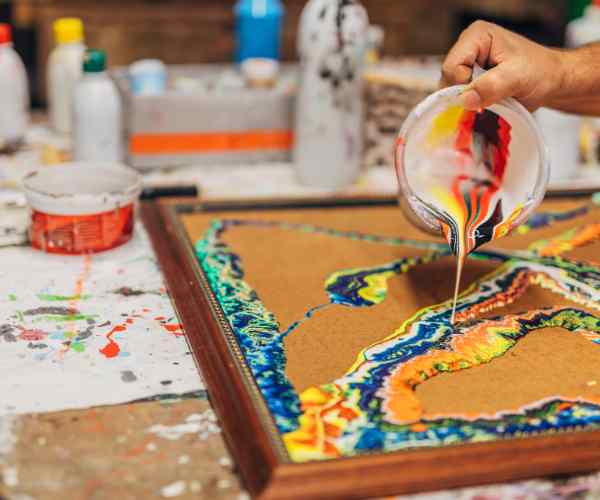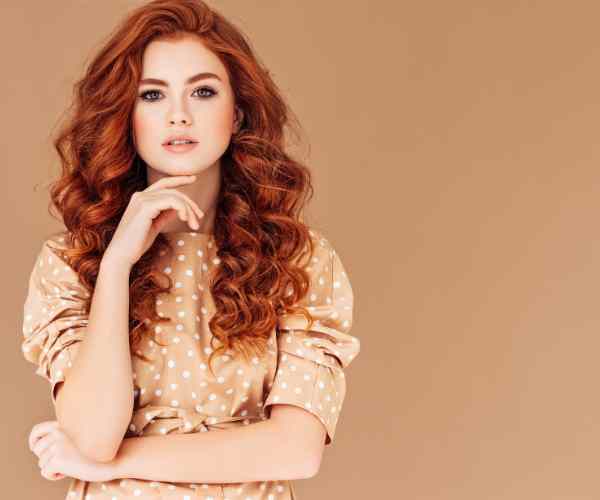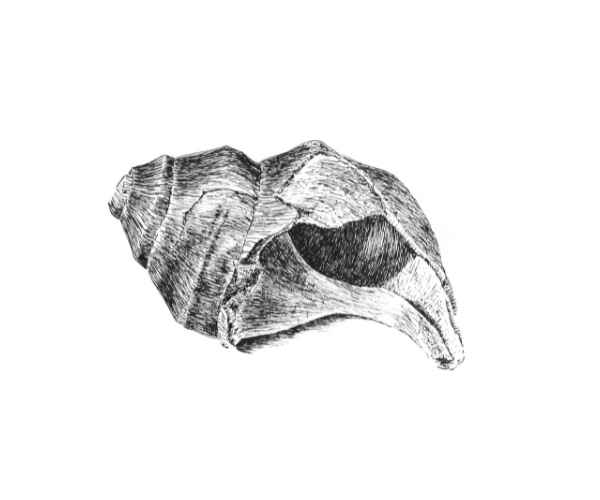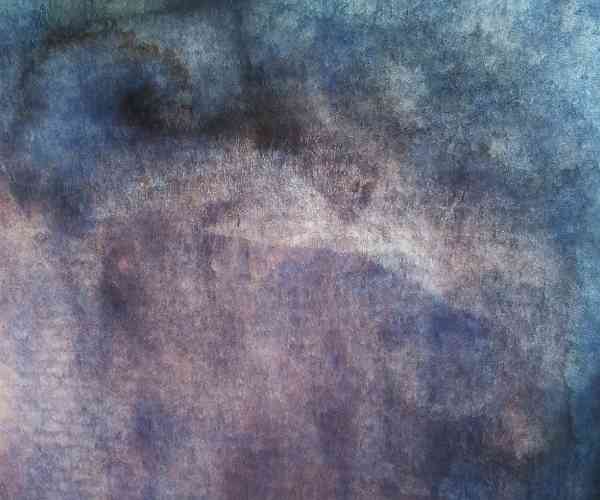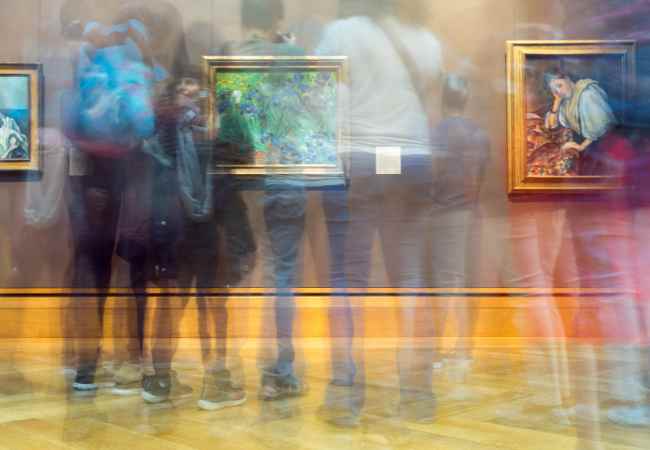When I think of Collages, I vision them as bonding of worlds. That may sound a tad bit absurd, but I stand by that—I envisage blending stories together and crafting a new one. Be it Paper, fabric, paint or photographs, they serve their own unique purpose. All of these elements combined create a narrative that is only possible in one singular form and with one singular narrative attempting to be told.
In this very post, we’ll be delving deeper into how the art of collage works, more so if you like to experiment with different materials or enjoy using your hands, you’ll definitely get something out of this. A collage is a multifaceted work of art, using fabric scraps, painted layers, or even upcycled found objects, collages bring them all together. History, ideas, and self expression—all of these elements make a collage what it is. Its part a visual story, and part a treasure hunt.
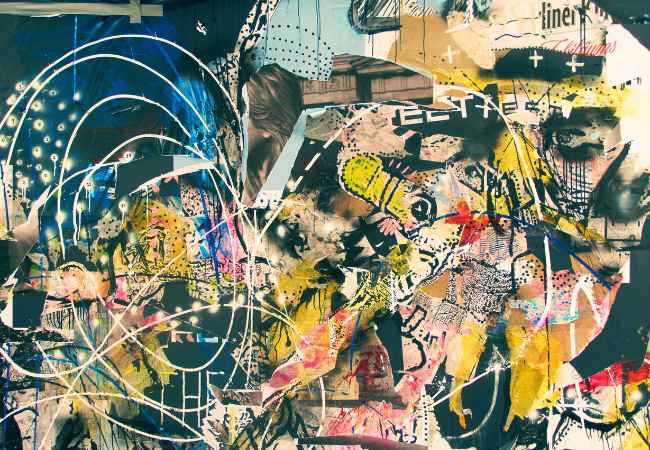
Voila, the best news for newbies and veterans alike in the art industry is that it doesn’t make a difference because combining different mediums feels wild and free. You are not restricted to any “guidelines” within conventional art. One good characteristic about collage that suits me best is that there are collateral boundaries, so to speak. Of course, there are practical aspects to be learned, but the most significant thing is being able to rely on your intuition. The beauty lies in the flow—grabbing what’s right in front of you and converting it into what you want.
However, collage does not stop at cutting and joining images, does it? It goes deeper as well. There are times when I think of a specific idea — but after I have pasted multiple textures, the idea starts transforming. This is how a new story starts taking place in my mind. More like a dialogue between the materials and me, each contributing some new aspect to the discussion.
So, for those artists seeking a break from their regular, or for those just starting in the realm of collage, what are we waiting for, let us begin. The borders do not exist over here, only the green light. What is required of you is the readiness to try out. So, are you ready to start creating your own world?
The History and Evolution of Collage Art
Collage in Early 20th Century Art
While collage might be seen as a relatively recent style, it took off thanks to the exposure it got from pioneers such as Pablo Picasso and Georges Braque in the early 1900s, and that was when it first began being treated as an art style. What continues to boggle my mind is how disrupitve that must’ve been at the time. To illustrate, you live in an age that treats painting and sculpture as the epitomes of high art, only to have someone exclaim, ‘What if I were to take a piece from a newspaper, shred it and glue it onto my painting?’
That is true in reference to Picasso and Braque. At the particular time Cubism was evolving, they also invented the usage of materials that had until the then not been included within the art scene – newspaper snippets, large sheets of glue, and pieces from fabric. It was a game changer! They were no longer confined to just a flat surface, instead, they began adding materials from their surroundings into the art pieces they created. It seemed to be a movement to us, “Why are we still trying to paint on a canvas? The brush can be used on a variety of surfaces new and old.”
By engaging in this activity, we were guided on how to decompose composition and materials alteration in new ways.
SoUnlike the other collage artists who focused on just representations of reality on a flat surface, this new group of collage artists sought to erase the boundaries set on art, they believed layers could form a 3D physical representation of an art piece. The materials which were used on the layer, solutions, and texture became just as, if not more, vital than the image span that image.
To me, this period in the history of art is special precisely because it is so radical. Artists did not follow the rules of art and from that, a whole new set of opportunities was opened up for countless future generations.
The Emergence of Multi-Media in Contemporary Art
As the 20th century progressed, collage art experienced another shift, the 20th century furthered the evolution of collage art. Collage began to take a new definition, it was no longer just taking cuts from paper, artists started to fuse different forms of mediums to create different outcomes. They were experimenting and altering 2D surfaces and defining capturing art.
I remember, the first time I came across a mixed media collage while making use of digital tools, I was blown away to the extent that my mind was bursting with what I could potentially create. It was precisely at that moment when I realized that it was no longer limited to the usage of tangible objects. With advancing technology, artists started integrating digital photographs, scanned textures, and images into their collages. Others even began using both analog and digital approaches simultaneously in order to make imaginative pieces of art that make use of both traditional collage techniques and digital artwork.
The reason why this is so thrilling about contemporary mixed media collage is because it truly appears to be not bound by boundaries. Just a few decades back, it was hard to even conceptualize layering paint, fabric, photographs, and even found materials and objects in such a way that would provide extra depth and dimension. Thanks to the emergence of new digital technology, the way in which impossible materials were not able to layer alone, you can experiment with layering in different ways including distortion and transparency.
Collage artists, including Wangechi Mutu among many others, create mind-bending pieces of work through the amalgamation of digital and analog traditions. She combines photography, found objects and the paint to question and grapple with the themes of culture, identity and the human body. It’s this kind of pushing-the-envelope kind of spirit that accepted collage as ART in the contemporary world still making it one of the most expressive and limitless forms of creative pursuits.
So, if you appreciate traditional approaches and sometimes wish to have the sensibility of a painter and sometimes to be equipped using a collage, or tend to make most out of what digital tools can do, then collage gives room to experiment these diverse methodologies together. Given the ability to combine and play around means collage is more than an artistic genre, but rather a maternal womb for creative evolution.
The Approach to Merging Various Forms of Art in the Collage
Material That Can Be Added to Collage Art
The most interesting aspect of collage art us how available it can be for artists, no need for expensive and complex tools. Its also important to note that some of the most personal and creative pieces I have seen were made out of things that would usually be discarded. I recall that once I did my first collage it was made from magazines that I could find in my house and I had a bunch of them. There was no set out plan, however, a theme began to crystalize when I started cutting images out and began relocating them. I felt as if the materials were assisting me to build a narrative, and before I knew it, I had produced something that looked like an embodied snapshot of my memories and life during that time.
At its heart, collage is nothing more than taking bits and pieces of different materials and joining them together. Once you have everything you need, the first step is to use a knife or scissors to cut the magazines and newspapers into portions that are suitable for your collage. If you draw your inspiration from vintage pieces, think about collecting unmarked or blank pages from old, dog-eared books. You’d be surprised how easily cutouts from magazines or articles can move someone’s heart. Anyone can surely follow this approach. So how about you pick some pictures and just cut elements of them out? You can also incorporate pictures of actors, flowers and ornaments. The POSSIBILITIES are endless! And the best part is, the amount of supplies you’ll need is literally free because family and friends are more than willing to lend you their old magazine and newspapers.
You could also usually just play around with mediums such as paint, fabric, stitching, modeling paste, paper, or whatever else sparks your creativity. Above all else, I value creativity; thus, I genuinely enjoy the introduction of contrasting images, diverse backgrounds, and the merging of various mediums. I draw primarily fabric structures, which is why I’m such a huge fan of collaborating with fabrics. When I was fifteen, I created a collage with letters from a necklace I’d composed for a friend. The antique bead scents still linger in my thoughts. The memories are vivid and warm me up from the inside out.
In collage art, the strangest of things can combine to tell a tale, and creating a compilation does not necessitate precision or refined resources. It could simply be every day objects that can be combined to become one’s exceptional narrative.
Other Tips to Suit Your Own Style:
Vis a vis creating an outstanding artwork, things do not need to start off in a complex manner, in fact, it is recommended to keep the cleanup and gathering process basic, so to use them as the first stepping stones of the thought process. For example: Collect items that can inspire you: start off by accumulating anything ranging from fabric remnants, old photographs, flowers, and even postcards. To elaborate, I was once able to incorporate an old metro card that I obtained from my last trip to Paris, and the artwork became a completely different piece as a result.
Remember Your Theme or Story: This step can be as structured or loose as you prefer. Certain individuals opt to sift through their thoughts with a concise idea at hand—perhaps a wish to tell a story about a feeling, an event or space that holds importance to them. In other instances, I simply collects my resources and wait for them to instruct me on what the theme needs to be. It boils down to what feels appropriate in that instance to you.
Start Arranging: This is the point where your instincts begin to take control. You can start placing your materials on any surface of your choice whether it is a piece of paper, canvas, or wood. Feel free to experiment with the arrangement by trying out different layouts. A collage can be assembled in quite a few ways so there isn’t a singular right or wrong way to go about it. Allow your materials to lead the way and go with your gut. After the first few minutes of arranging, more often than not, I discover a specific story or pattern that I hadn’t even thought of appearing.
Glue It Down: After you are satisfied with your arrangement, it is time to start gluing the pieces down to the surface. But keep in mind that a collage is quite versatile. If you feel like doing something different, it is perfectly acceptable! One of the wonderful aspects about this medium is that you can constantly overlap and rearrange things until it seems to fit.
Add finishing touches: This is the stage that I find the most entertaining! When all the pieces are already glued, you may decide to paint over the entire piece or even add some texture or layers. I have used acrylic paint on many occasions to either deepen or brighten certain aspects of the artwork. If the effect I am trying to produce is not satisfactory enough, then a fine marker will sometimes be used to draw specific details or outlines to complete the composition. This is the part where the mixed media magic happens so make sure you don’t hold back while trying new things!
Tips for Blending Different Media
The incorporation of various media components when creating a collage is not as simple as it may seem, nonetheless, its difficulty only adds to the excitement. One of the most relevant aspects to have in mind, however, is the concept of unity. When combining elements, such as, paper, fabric, paint, and three-dimensional objects, consider how they interact. Are their textures in unison? Are the hues coordinating?
Speaking of color, this is where colour theory comes into play. Working on a collage does not mean you can neglect design principles, and hence lack cohesiveness. I am always conscious of the level of warmth versus coolness of tones in the result or how a mere tint of the complementary pigment in the composition vibrates.
Composition is an important concept in collage too. It`s true that collage can appear messy but it doesn’t have to be. Consider composition and placement of your elements are you assisting people’s gaze around the collage Are you presenting a particular aspect of your collage or is it designed to provide a broad interest across the entire space?
Collage is the perfect type of art as it is a perfect balance in order and mess, but if you add a little guidance the end result will look professional and done on purpose.
Collage Art In Real Life Context
When I think of collage art I think of certain people instantly. One of the collage artists that narrowly casts influence over me is Hannah Höch, a well known collage artist who was part of the Dada movement and was one of the first people to engage in photomontage Using collage, she utilized existing imagery to develop collage artworks based on politics, in particular on gender and even identity. Her work, in particular, shows that collage can be more than simply aesthetics and can actually reflect deeper issues within the society.
Kurt Schwitters is yet another eminent name in the history of collage. He is associated with the creation of three-dimensional texts which use found objects and other materials. There is something so beautiful in the way he transforms a very basic bus ticket or an old scrap of paper, into something that is more emotional and meaningful. He inspires me to imagine and visualize more that how art can actually exist in the most weird places.
If we move to the modern world, then I am very much fascinated by Wangechi Mutu, she creates/paints and mixes the digitals and the analog to comment on certain issues such as identity or culture, relating to the female body and the African diaspora. Her works are beautiful, first on the purely aesthetic level and second because there are so many layers – literally and metaphorically – contained within them. She combines paint, digital media and anything else to build these breathtaking figures. It shows that collage can be as conceptual and intelligent as other forms of art.
Everyday Collage Artists: Heroes Behind The Story
For collage art, no one has to spend a fortune on collage art supplies. And this is one of the things I like most about the collage. There are many artists I have met who began making collages to preserve their life stories. For example, one particular artist I know will take old family portraits of people and collage them over some lace alongside written letters. It’s like making a scrapbook, but less one dimensional.
Another artist I met collects natural elements – things like leaves and sand and pressed flowers and puts them in her own works. She claimed these materials determine the piece just as much as the final collage does. It is how she can get in touch with nature and bring a little bit of nature into her art.
Everyday creators illustrated here, demonstrate that one need not be a celebrity or have a brand name supply to be able to produce art that’s deeply profound and impactful. In fact, collages made of the simplest objects, the most personal stories often times are the most incredible.
Having a Hard Time With Composition?
Today I want to talk about Composition, something that sets the highest of barriers when starting out with collage making. Imagine the first time you see a collage all you can see is a ton of amazing pieces, magazine clippings, pieces of fabric and some random photos, and all of them want your attention at the same time. Take me back to the first time I tried to make a collage I spent hours just shifting things without committing to it because it was a too much to take in.
One of the best methods and fixes I have devised and adapted is choosing a color palette or a theme. You want to reduce your options of colors or tell a particular story, instantly you have a frame what works and what doesn’t. Let’s say I want to create a collage that is based on nature, so I use the warms of green brown and blue with organic shapes like leaves or flowers. So this has turned all the confusion with materials into a framework that makes sense.
Talking about collages, I can share with you a technique that might prove to be useful: approach your collage in layers. Consider the collage a type of visual narrative with a background and layers that add to the collage, one upon the other. I remember once constructing a collage around the concept of time. Because I approached it from a sequential standpoint, each layer of the collage went through that story. It was just so entertaining to play with composition and yet make everything work together.
Managing Multiple Collages While Still Retaining a Single Idea
This is a problem each and every collage artist encounters at some stage. You know exactly the idea you want to actualize, for example, there is a collage on nostalgia you want to create, or, there is an art collages on urban energy and so on – then, out of nowhere, you get overwhelmed by the broad choices of materials you have. I have been there so many times. The desire to incorporate all the materials is overwhelming because each one is unique and has something new to offer, but before you know it, that idea becomes the least of your concerns.
Here’s what works, I’ve discovered: back off when it seems as though you are losing focus with the vision. In some situations, that is making adjustments to the decisions made and discarding them. I remember doing a collage in which I wanted to work with memory, but at one point I noticed that I was adding too many unrelated things: ribbons, beads and even small bits of fabric. I had to take a step back get more objective and determine what exactly was useful to the narrative I was creating. Sometimes less is more.
Something else to consider is how layering is intended. If for example, you are joining various media, such as fabric with paints or digital with analogue, all these aspects should be viewed as additional to your vision rather than obstructions. Consider, “Is the new material furthering my narrative, or is it simply extraneous?” I have learned that when I place my idea at the center, the materials also serve its purpose: complements not competes.
Bridging The Gap Between Optimism and Pessimism
This is one of those things that makes collage so fun yet so tricky – switching between chaos and order. Collage can be considered as a few sheets of paper glued together why heavily and that is how collage is. But if everything is chaotic, it will be difficult for viewers to understand exactly what the piece is about or where to focus their attention on. I often had this challenge in the early days, particularly when I focused on making more extravagantly designed pieces that used a greater range of colors than usual. It was as if I was so engrossed in the joy of creation that I lost track of balance.
Contrast is one of the important things which can help you achieve this equilibrium. If there is plenty of color in a pattern, let the pattern’s borders be colorless or coated with a single color. Consider it a refreshing post. For instance, I recall creating something bright and lively, with a lot of aggressive patterned elements sharing space and time with vibrant colors; however, it seemed a little much for a first impression to bear. So I placed a sizable unvarnished circle in the middle, which made the centerpiece and the issue more approachable.
Another aspect of the work to really pay attention to is texture. I personally enjoy using different textures in collages to add relief. For instance, juxtaposing a jagged torn fabric to uncoated magazine paper generates an effect. The contrast manages to maintain order amongst the disorder without being overly restricted in feel. Everything is about the balance between being random and being deliberate without the two sides meeting entirely. That is the area where everything great occurs.
Common Questions: Collage Making Process and Working with Diverse Media
Which material is the most appropriate for collage art?
It can be stated that there is no specific material that stands out. Everything is determined by the end result you want to achieve. Paper including those collected from magazines, newspapers, or even worn books, for some are the most obtainable and versatile material, so it would be their first choice. Others, however, may favor fabric, wood, or found objects to add additional layers and depth. On the other hand, I adore layering multiple materials depending on the story being told. For example, my collages use lace, cardboard, and pressed flowers, among other things. It is all limitless, and that is why collage making is so much fun!
Would you be able to use digital images within a collage alongside the ordinary media in collage making?
Of course! Nowadays many artists are producing amazing hybrid works that combine traditional approaches and contemporary digital work. Printed out digital images can be a part of a physical collage, some layered paint or texture can be added on top. Or alternatively, A made collage could be scanned and altered in a software to allow additional elements to be added. There are so many possibilities with the merging of analog and digital, why limit yourself to just one?
Do I have to consider design rules in collage?
Definitely not! This is one the greatest aspects of collage as it entails freedom and combination of different ideas at once. Sure a fundamental knowledge of design helps (like composition, color theory, balance etc), but collage is the area where you can be quite adventurous. At times, the rules can be bent to get the most interesting and intriguing outcomes. That said, however, when if you feel sort of baffled or strange from looking at the work, consider considering more basic graphic design principles so your artwork feels more organized and pleasing.
**Conclusion**
In the end, collage art is limitless, so grab your fabrics, layering tools, and anything else you’d like to experiment with, and get to work because there is no wrong way of making a collage! There is no restriction, framework, procedure, or any conventional way of applying collage, which is what makes it a vibrant art. All you need to have is: vision, and confidence to go for it! That being said doing a proper composition while balancing chaos and order, is however a challenge, but once completed the glorious piece is bound to be ‘collage art,’ or ever changing art!
In the end, fusion is the key!

